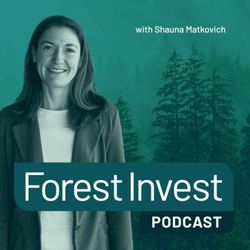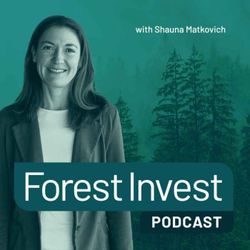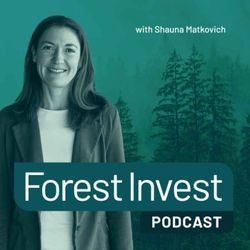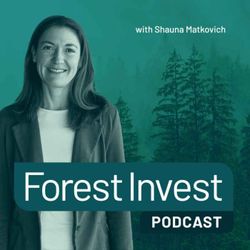Share

Forest Invest
Bringing you expert insights on creating profitable and impactful forest investments.
Latest episode

68. Development Finance for Emerging Market Forestry – with Anton Timpers of FMO
38:50||Season 2, Ep. 68The ForestLink newsletter sign-upAnton Timpers (LinkedIn)FMOToday on Forest Invest, I am joined by Anton Timpers, Manager of Agriculture, Food and Forestry at FMO, the Dutch entrepreneurial development bank.Anton explains how FMO approaches forestry as part of its wider agribusiness and sustainable land-use strategy. We discuss how the bank invests across the full forestry life cycle, from early-stage plantation projects to mature industrial forestry in emerging markets. Anton also outlines why FMO continues to support sustainable plantation forestry as a cornerstone of the future bio-based economy.We explore the role of blended finance and concessional capital in crowding in private investment, and how development finance institutions can help reduce risk in frontier and emerging markets. Anton highlights the environmental and social safeguards FMO applies to avoid deforestation, ensure certification, and prevent greenwashing in forestry projects.Anton also shares FMO’s ambition to invest up to 1 billion euros in forestry and sustainable land use by 2030. We talk about the challenge of finding truly bankable forestry projects in fragmented markets across Latin America, Africa and Asia, and what potential investees need to have in place before approaching a development finance institution like FMO.We are convinced about the opportunities in emerging markets, and we hope that with global supply shifting, people will consider these locations more seriously. Chapters [00:23] Meet today’s guest: Anton Timpers (FMO) [00:34] Favourite tree [01:02] Anton’s background and intro to FMO [02:05] Building FMO’s forestry focus [02:33] What makes FMO’s approach unique [03:58] Investing across the asset maturity spectrum [04:45] Co-investors and partners [06:03] Appetite from commercial investors [06:32] Plantation forestry vs natural forests [08:20] Conservation, restoration and carbon risks [10:13] Safeguards, certification and due diligence [11:29] Why forestry moved into the agri team [13:04] Standards, safeguards and risk frameworks [14:26] FMO’s €1 billion forestry goal [15:53] Main obstacles and fragmented markets [17:49] Industrial demand and medium-sized enterprises [20:01] Illegal logging and market realities [21:47] Small global community of forestry investors [23:21] What potential investees should know [25:14] What to prepare before approaching FMO [27:07] Direct equity vs fund-led co-investments [27:50] COP discussions, pledges and Brazil focus [29:39] Carbon credits, accounting and market gaps [31:03] Positive momentum from COP [32:06] Geographic focus: LatAm, Africa, Asia [33:29] Concessional capital and early-stage funding [35:36] How to approach FMO with an opportunity [36:00] Final reflections [36:11] Actionable advice for first-time forest investorsProduction teamFounding Director and Host: Shauna Matkovich - The ForestLinkProducer and Editor: Magdalena Laas - Unscripted Creatives Nature by MaxKoMusic/SoundcloudSopwell Woodlands and Scohaboy Bog SAC, Cloughjordan, Co Tipperary, IRELAND by wild_rumpus/Soundcloud
More episodes
View all episodes

67. A Social Impact NZ Forest Carbon Investment Model – with Blair Jamieson
51:01||Season 2, Ep. 67The ForestLink newsletter signupTāmata HauhāBlair Jamieson on LinkedInWe’ve proven that it works — that you can invest in Māori land, generate real returns, and create meaningful change.In today’s episode, I’m joined by Blair Jamieson, CEO and Co-Founder of Tāmata Hauhā, a New Zealand–based company leading the way in Māori land investment, carbon forestry, and sustainable land-use transformation. Blair shares how his background in government shaped the creation of this mission-driven organisation, which helps Indigenous Māori landowners unlock economic opportunities by developing under-utilised land into long-term, intergenerational assets that generate both social impact and financial returns.We explore the realities and complexities of Māori land ownership and why building trust requires what Blair calls a “thousand cups of tea” approach — patient, relationship-centred engagement grounded in cultural respect. Blair explains how Tāmata Hauhā blends cultural integrity with commercial pragmatism, collaborating with more than 70 Indigenous groups to establish forests that deliver economic, community, climate, and biodiversity benefits.Blair also breaks down New Zealand’s Emissions Trading Scheme (NZ ETS), offering rare insights into how this compliance-based carbon market provides credibility, transparency, and liquidity unmatched by most voluntary carbon systems. We discuss the company’s investment model, expected returns, and its expansion into the Chatham Islands, where carbon forestry is reshaping remote communities and supporting nature-based climate solutions.Chapters00:00 – Welcome & Introduction00:23 – Meet Blair Jamieson & Tāmata Hauhā01:21 – What the Company Does02:25 – Blair’s Background in Government03:17 – Forestry as an Economic Enabler for Māori Land04:12 – Working with 70+ Indigenous Groups05:05 – Community Impact & Commercial Returns06:11 – Māori Land Ownership Explained09:39 – The “Thousand Cups of Tea” Approach12:39 – Māori Leadership Within the Company14:29 – History of Radiata & NZ Forestry17:35 – Moving Beyond Pine Monoculture20:06 – Nurse Crops & Native Regeneration22:27 – NZ Emissions Trading Scheme (ETS) Overview24:30 – How NZU Compliance Markets Work31:51 – Carbon Prices & Market Dynamics33:38 – Investment Model Explained35:26 – Chatham Islands Projects39:35 – Māori vs Moriori: Cultural Context41:48 – Main Risks: Politics, Not Integrity45:12 – What’s Next for Tāmata Hauhā47:17 – Scaling & International Interest47:51 – Final Advice for New Forestry InvestorsProduction teamFounding Director and Host: Shauna Matkovich - The ForestLinkProducer and Editor: Magdalena Laas - Unscripted CreativesSound libraryNature by MaxKoMusic/SoundcloudSopwell Woodlands and Scohaboy Bog SAC, Cloughjordan, Co Tipperary, IRELAND by wild_rumpus/Soundcloud
66. Restoring the Andes: Global Lessons from Ancient Wisdom – with Florent Kaiser
57:32||Season 2, Ep. 66The ForestLink newsletter signupGlobal Forest GenerationAcción AndinaFlorent Kaiser (LinkedIn)Earthshot PrizeIn this episode, I’m joined by Florent Kaiser, CEO of Global Forest Generation and co-lead of Acción Andina, winner of the 2023 Earthshot Prize. Florent shares how a grassroots movement born in the Peruvian Andes has evolved into a six-country restoration effort—reviving the world’s highest forests by combining Indigenous principles of Ayni (reciprocity) and Minka (collective service) with modern science, technology, and climate finance.We explore what authentic community engagement looks like in practice, how to balance trust and expectations in long-term partnerships, and why forest restoration must begin by listening—to people, to landscapes, and to water.Florent also outlines the next phase of Acción Andina’s mission: linking forest restoration and water security to attract new forms of capital, and inviting investors to build relationships rooted in dignity, co-ownership, and respect.Seeing tens of thousands of people planting trees together isn’t just ecological restoration — it’s an act of hope. It reminds us that working with nature unites us beyond economics or politics.Chapters[00:00] Welcome & introduction – Shauna Matkovich and Florent Kaiser (Global Forest Generation / Acción Andina) [01:00] From childhood curiosity to creating a global forest movement [03:00] Founding Acción Andina and Global Forest Generation [07:30] How Indigenous principles of Ayni and Minka guide restoration [12:30] What real community leadership and engagement look like [17:00] Winning the Earthshot Prize and what it means for restoration [21:30] Building trust and managing expectations with local partners [33:00] Linking forest restoration with water security and long-term finance [49:00] Blending ancient wisdom with modern tools and innovation [54:00] Advice for investors: visit, listen, and invest in relationshipsProduction teamFounding Director and Host: Shauna Matkovich - The ForestLinkProducer and Editor: Magdalena Laas - Unscripted CreativesSound libraryNature by MaxKoMusic/SoundcloudSopwell Woodlands and Scohaboy Bog SAC, Cloughjordan, Co Tipperary, IRELAND by wild_rumpus/Soundcloud
65. The Carbon Paradox – with Renat Heuberger
54:26||Season 2, Ep. 65The ForestLink newsletter signupThe Carbon ParadoxTerra Impact VenturesRenat HeubergerRenat Heuberger, CEO of Terra Impact Ventures and author of The Carbon Paradox, joins host Shauna Matkovich to explore why the forest carbon market is both vital and fiercely debated. He unpacks key paradoxes — from the “baseline” paradox that rewards past deforestation to the “leakage,” “control,” and “transparency” paradoxes that trap project developers between local realities, investor demands, and media scrutiny.Heuberger reflects on his exit from South Pole, the damage caused by polarised climate debates, and why scrapping REDD+ would mean abandoning the only proven tool to protect forests still disappearing today. Through his fiction-based narrative, he aims to reach readers outside the carbon bubble — including his 80-year-old mother — and believes the next wave of forest-climate leadership will come from students and founders ready to reshape the story.His message to investors: now is the moment to “buy the dip” in forest carbon — for those patient enough to ride out the noise.That’s already the first paradox we describe, right? Is it ethically correct to put a price on nature, to call forests an asset? … At the same time, if you are not giving a price to nature, then in a way its price is zero. And that’s already the first fundamental debate which has been going on in carbon markets for several years0:00 Intro – Welcome to Forest Invest0:19 Guest intro – Renat Heuberger, Terra Impact Ventures & The Carbon Paradox1:18 Origins – First encounters with deforestation in Indonesia2:25 Building South Pole and early carbon-market journey4:43 The first paradox – Putting a price on nature6:11 Why write a fiction-based book about carbon markets7:42 Writing for readers outside the climate bubble9:40 The power of storytelling over white papers10:40 Key paradoxes – Baseline, Leakage, Community16:00 The Control Paradox – Who really decides how forest funds are used22:31 The Ideologists Paradox – Attacks from left and right25:19 The Transparency Paradox – When openness invites criticism27:14 Meet the protagonists – Three students on a climate mission29:25 Reconciling forests as moral duty vs market asset33:04 New ideas – Pricing nature, not just carbon35:17 Political cycles, slow progress, and REDD+ lessons37:24 Rebirth of the Dream – Why narrative change matters39:30 Raising a questioning generation41:34 Leaving South Pole – What really happened45:25 Silver linings and new beginnings47:03 Who should read The Carbon Paradox – Greta Thunberg & President Prabowo49:50 Message to project developers – Hang in there51:23 Investor takeaway – “Buy the dip” in forest carbon53:00 Where to find the book & Renat’s workFounding Director/Host: Shauna Matkovich - The ForestLinkProducer/Editor: Magdalena Laas - Unscripted CreativesSound LibraryNature by MaxKoMusic/SoundcloudSopwell Woodlands and Scohaboy Bog SAC, Cloughjordan, Co Tipperary, IRELAND by wild_rumpus/Soundcloud
64. REDD+ Under Pressure – with Michel Schuurman
49:03||Season 2, Ep. 64The ForestLink newsletter signupREDD++ Business InitiativeTreeviveIn this episode, Shauna Matkovich speaks with Michel Schuurman, Director of Business Development at TreeVive and Chair of the REDD+ Business Initiative, about the slowdown in corporate demand for avoided deforestation credits and why REDD+ remains the most scalable, cost-effective way to protect tropical forests. Drawing on two decades in sustainability and climate finance, Michel explains how reputational risks and investment barriers are stalling progress, and why jurisdictional nesting alone won’t move fast enough. He outlines what high-integrity REDD+ looks like — community-driven design, FPIC, shorter MRV cycles, and national alignment — and calls for continued private-sector engagement.His message: don’t wait for perfection — keep REDD+ in the portfolio, or we lose forests faster than finance flows.Ask someone as a citizen if they would protect forests, and they’ll say yes. Ask them as a corporate communications officer if they’d invest in a REDD+ project, and they’ll say maybe — or no. That’s the gap we need to close.Chapters 0:23 Guest introduction – Michel Schuurman, TreeVive & REDD+ Business Initiative 1:26 Michel’s professional journey and path into forest carbon finance 5:15 Major shifts in forest carbon and avoided-deforestation markets 6:25 Role of the private sector vs governments and NGOs in forest protection 8:52 Why carbon remains the key measurable value metric 10:54 Challenges with valuing intact forests and improving REDD+ mechanisms 13:17 Overview of REDD+ Business Initiative report and its aims 17:01 Addressing media criticism and project integrity in REDD+ 19:26 What’s improving in methodologies and MRV tools 19:27 Three biggest financing gaps in forest protection 21:17 Corporate reputational risk and reluctance to engage 22:39 Policy and Article 6 uncertainty as a major barrier 24:33 Market slowdown and optimism for renewed momentum 26:15 What defines a high-integrity REDD+ project design 27:12 Community engagement, FPIC and benefit-sharing models 29:34 Technical integrity: baselines, MRV cycles, permanence and leakage 31:53 Investor profiles suited to REDD+ projects 33:00 Why institutional capital hesitates and the funding-size gap 35:49 Why capital isn’t flowing despite low ticket sizes 37:06 State of impact and philanthropic investment in REDD+ 38:13 Jurisdictional vs private-project approaches and time lags 40:22 How developers can de-risk and protect their projects 41:02 Emerging insurance and policy-risk products 41:40 Blended-finance tools to mobilize private capital 44:13 Final call to action – keep forest protection in portfolios 45:26 Role of media and balanced reporting 48:00 Closing remarks and where to find the REDD+ Business Initiative reportFounding Director and Host: Shauna Matkovich - The ForestLinkProducer and Editor: Magdalena Laas - Unscripted CreativesNature by MaxKoMusic/SoundcloudSopwell Woodlands and Scohaboy Bog SAC, Cloughjordan, Co Tipperary, IRELAND by wild_rumpus/Soundcloud
63. The Economic Case for Forest Restoration in Brazil with Niamh McCarthy and Alexandre Köberle
58:46||Season 2, Ep. 63Today, I’m joined by Niamh McCarthy, Senior Director of Climate-Related Risk, and Alexandre Köberle, Senior Fellow at Orbitas—an initiative of Climate Advisors. We explore their report Room to Grow: The Economic Case for Forest Restoration in Brazil, showing how climate transitions open new investment pathways in Brazil’s land economy. Orbitas’ scenario analysis quantifies financial risks and opportunities in forestry and agriculture, revealing a $141 billion restoration potential and 369,000 new jobs by 2050. Niamh and Alexandre share where large-scale restoration makes economic sense, how blended finance, green bonds, and carbon markets are evolving, and why local expertise and due diligence are vital for investors in Brazil.QuoteWhat’s exciting about restoration in Brazil is that it represents an investment opportunity that’s both profitable and a genuine climate solution. - NiamhBrazil could actually become a net negative emissions country, exporting negative emissions to the rest of the world — that’s how large the potential for carbon sequestration is. - AlexandreUseful ResourcesThe ForestLink newsletter signuporbitas.orgChapters[2:42] What Orbitas does — assessing climate-related risks and opportunities[6:21] Scenario analysis and transition risk explained[7:23] Using TCFD framework and standard terminology[9:22] Brazil report — “Room to Grow: The Economic Case for Forest Restoration”[10:08] Methodology and headline findings[11:27] Agricultural drivers and degraded pasturelands[12:23] Profitability and financing mechanisms[13:37] Political will and policy alignment in Brazil[14:43] Surprises and confirmations in the analysis[17:01] Why focus on Brazil versus other countries[19:15] Regional focus — where restoration makes most sense[21:19] Importance of the Amazon and Cerrado ecosystems[23:10] Hydrological and climate resilience links[26:14] Investment risk, transparency, and blended finance[30:35] Restoration archetypes and financing mechanisms[33:39] Emerging trends — agroforestry and new markets[35:35] Carbon markets, ETS, and biodiversity credits[39:12] How climate transitions affect profitability[42:29] Market proximity and economic feasibility[43:00] What investors should ask before investing[45:15] Importance of due diligence and local partnerships[46:10] Calls to action for government and corporations[48:49] Policy implementation and land governance challenges[50:30] Role of other stakeholders and communities[51:34] Ensuring fair distribution of returns[52:22] Corporate responsibility and supply chain influence[54:18] Profitability even without strong transitions[55:06] Final advice for new forest investors[57:10] Building trust and long-term partnerships[57:38] Closing thoughts and where to learn moreProduction TeamFounding Director and Host: Shauna Matkovich - The ForestLinkProducer and Editor: Magdalena Laas - Unscripted CreativesSound LibraryNature by MaxKoMusic/SoundcloudSopwell Woodlands and Scohaboy Bog SAC, Cloughjordan, Co Tipperary, IRELAND by wild_rumpus/SoundcloudAmbient Documentary by Sound Guru (Pixabay)
62. New York Climate Week: Take-aways for Forest Climate Finance – with Jen Stebbing
35:30||Season 2, Ep. 62In this episode, I speak to Jen Stebbing, a communications strategist working at the intersection of climate, nature, and markets. Jen shares her key takeaways from New York Climate Week, where forests are increasingly being seen as essential infrastructure rather than “nice-to-haves.” We discuss the emerging portfolio approach to forest finance—integrating conservation, restoration, improved management, and avoided deforestation—to help investors and policymakers see the full picture. Jen also shares insights on Brazil’s leadership through the Tropical Forests Forever Facility (TFFF), the role of blended finance and philanthropy in catalyzing capital, and the importance of risk-sharing models that protect communities. She encourages listeners to explore the Forest Finance Roadmap as a key resource for developing new forest investment strategies.“I’m going to come back to my infrastructure point. So see forests as an essential, durable infrastructure and think about the portfolio — conservation, restoration, jurisdiction, sustainable forestry, all of these things together. And remembering that the biggest risk isn’t reversals, it’s delay. So the more you step in, the more value you have secure.” Useful ResourcesThe ForestLink newsletter signupJen StebbingJen Stebbing (LinkedIn)TFFF - Tropical Forest Forever FacilityGeneration Restoration: How to Fix Our Relationship Crisis with Mother Nature (book)HIFOR - A single investment, with multiple benefitsChapters[0:00] Welcome and introduction[0:21] Meet Jen Stebbing[2:00] Highlights from New York Climate Week[5:00] Forests as essential infrastructure[8:46] The portfolio approach to forest finance[11:41] Indigenous leadership and equity[13:42] Brazil’s TFFF and the Forest Finance Roadmap[18:13] Risk-sharing and community protection[21:47] Blended finance and the Restoration Generation[29:05] Overcoming capital-raising challenges[33:03] Optimism and collaboration in climate finance[34:10] Final advice for forest investorsProduction TeamFounding Director and Host: Shauna Matkovich - The ForestLinkProducer and Editor: Magdalena Laas - Unscripted CreativesSound LibraryNature by MaxKoMusic/SoundcloudSopwell Woodlands and Scohaboy Bog SAC, Cloughjordan, Co Tipperary, IRELAND by wild_rumpus/SoundcloudAmbient Documentary by Sound Guru (Pixabay)